Log siding homes are super cozy places to live in and enjoy life. Your home should be built with as much protection from the elements as possible. One often overlooked issue you must avoid is the lack of thorough moisture barriers.
Installing adequate moisture barriers throughout your log home in the right places can prevent wood rot, metal corrosion, and health issues. Excess moisture can generate mold and mildew that can be costly to remove and repair. Let’s explore why quality moisture barriers are critical for any home.
The Purpose of Log Home Moisture Barriers
Home moisture barriers, also known as vapor barriers, are materials designed to prevent moisture from entering and damaging your home’s structure and finishes. They come in various forms including plastic sheeting, foil sheets, foam insulation, and specialized paint. Moisture barriers are crucial for preventing mold, mildew, health, and other moisture-related issues.
Moisture barriers are installed as a log home’s construction progresses through each stage. Excess moisture can wreak havoc on a log siding homes’ structure that can lead to wood rot, metal corrosion, and cracked concrete. Thorough moisture barrier installation can extend the life of your home.
Mold and mildew thrive in damp conditions that not only cause damage but they can also create costly repairs. Moisture barriers help keep critical parts of your log home dry, reducing the risk of wet surface problems.
Exterior And Interior Walls
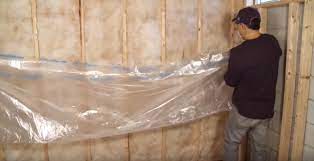 Barriers in exterior walls keep outdoor moisture out and prevent indoor moisture from condensing within the walls. Moisture barriers are important behind drywall in high-moisture areas. In bathrooms and kitchens, they can help prevent water vapor from accumulating behind drywall and causing problems. The following are effective wall moisture barriers:
Barriers in exterior walls keep outdoor moisture out and prevent indoor moisture from condensing within the walls. Moisture barriers are important behind drywall in high-moisture areas. In bathrooms and kitchens, they can help prevent water vapor from accumulating behind drywall and causing problems. The following are effective wall moisture barriers:
- Polyethylene Film is a common and economical material but is not air permeable.
- Foil-Faced Insulation acts as a vapor retarder.
- House Wrap is often more permeable than polyethylene film and allows some moisture to escape.
- Smart Vapor Retarders are designed with perm ratings and adapt to different moisture and temperature conditions to allow for more effective drying.
Windows And Doors
The easiest way to seal your windows and doors is to caulk around them with a high-quality material to prevent moisture damage. Other ways to protect windows and doors include:
- Tape can be used as a moisture barrier. Specially formulated tapes made from aluminum and polyester can be applied directly to window and door edges.
- Plastic, asphalt, or a thinner film vapor barrier helps keep out moisture, wind, and cold air, helping to heat it more efficiently in the winter.
- High-Quality windows and doors rather than construction grade ones are wise investments that can protect against moisture and other issues.
Log Home Moisture Barriers Under Floors
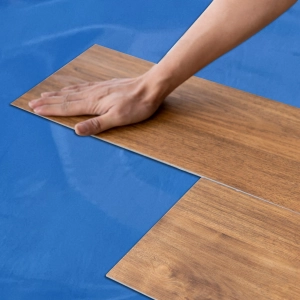 Placing barriers under floors is a smart idea. When installing wood flooring over concrete, a moisture barrier protects the wood from damage caused by moisture on the concrete’s surface. The same goes for barriers under subfloors before the top flooring material is laid down.
Placing barriers under floors is a smart idea. When installing wood flooring over concrete, a moisture barrier protects the wood from damage caused by moisture on the concrete’s surface. The same goes for barriers under subfloors before the top flooring material is laid down.
Always refer to the manufacturer’s instructions for your specific flooring and moisture barrier products. Opt for high-quality moisture barriers and adhesives to ensure a durable and effective seal. Consider using a dehumidifier in areas prone to high humidity.
Basements And Crawl Spaces
Moisture barriers are essential in log home basements and crawl spaces to prevent ground moisture from seeping into the house and causing issues like mold and rot. They are needed under concrete slabs to prevent moisture from seeping up. Ensure proper ventilation in crawl spaces to help prevent moisture buildup.
Crawl spaces need moisture barriers to also reduce pest, insect, and structural damage to your log siding home that comes from excess moisture. Consider using a dehumidifier under the house if you live in a rainy and high-humidity area.
Log Home Moisture Barriers In Ceilings
Moisture prevention can be used in ceilings to stop damage caused by water leaks, high humidity, and condensation. When upgrading insulation, incorporate a ceiling vapor barrier to enhance the overall effectiveness of the insulation material. Use a barrier in cold climates when the temperature differences between indoor and outdoor environments lead to condensation within the ceiling.
Ceiling moisture barriers may not be necessary in hot, dry climates or when the ceiling areas are adequately ventilated. Some building designs and materials naturally resist moisture, making vapor barriers less critical.
Climate Considerations
In cold climates, moisture barriers should be placed on the warm (interior) side of the insulation to prevent indoor moisture from condensing in the wall. In hot and humid climates, moisture barriers should be placed on the cool (exterior) side of the insulation to prevent outdoor moisture from entering the wall.
In Conclusion
Consult with an experienced building contractor and a moisture barrier specialist before building your log siding home and selecting barrier materials. Don’t overlook this critical area of home construction and you will reap the benefits.


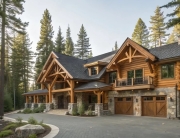
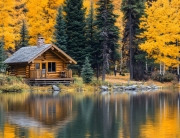
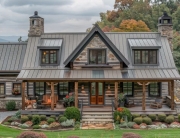
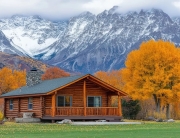
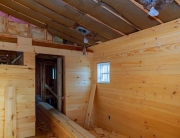
Recent Comments